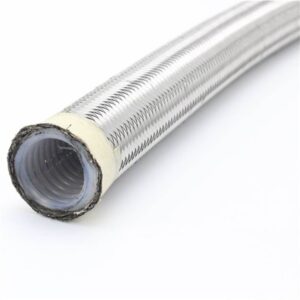Teflon and polytetrafluoroethylene (PTFE) are two commonly used terms in the materials and manufacturing fields. Both possess nonstick properties as well as excellent heat resistance and chemical resistance. However, there are also differences between them.
This article will introduce Teflon and PTFE, stating their definitions, comparing their characteristics and applications, and highlighting the key differences between them.
What is a Teflon hose?

A Teflon hose is a flexible tubing made of polytetrafluoroethylene (PTFE, commonly known as Teflon).
Teflon Definition
Teflon is the trademark name of DuPont for its polytetrafluoroethylene (PTFE) and related derivatives.
Therefore, strictly speaking, Teflon is a general commercial term for a class of products or coatings containing PTFE. This includes various high-performance industrial products and everyday consumer goods made from PTFE, such as non-stick cookware coatings, seals, cable insulation, and chemical equipment linings.
All Teflon products are developed based on the properties of PTFE, but not all Teflon products are called PTFE. In other words, Teflon is a brand representation of PTFE. Its widespread use and brand recognition lead people to often refer to the non-stick, heat-resistant, and corrosion-resistant properties of PTFE as "Teflon," but this does not change the essential properties of its core material—PTFE.
Teflon characteristics
Low Friction: The smooth surface of Teflon material minimizes friction, reduces pressure drop, and improves fluid flow efficiency.
Chemical Resistance: Teflon material exhibits strong resistance to a wide range of chemicals, including acids, alkalis, solvents, and fuels.
Temperature Resistance: Teflon hoses can withstand a wide temperature range, from extremely low to extremely high temperatures.
Non-stick Properties: The non-stick properties of Teflon material prevent the buildup of substances inside the hose, ensuring smooth fluid flow.
Flexibility: Teflon hoses are flexible, allowing for easy wiring and installation in a variety of applications.
What is a PTFE hose?

PTFE is an abbreviation for polytetrafluoroethylene, a fluoropolymer synthesized from tetrafluoroethylene. It is the main component of Teflon, known for its excellent non-stick properties and superior heat and chemical resistance.
Polytetrafluoroethylene (PTFE) Definition
PTFE is a perfluorinated polymer compound composed of closely packed carbon and fluorine atoms, exhibiting an extremely stable chemical structure. This material's unique properties, such as extremely low surface energy, excellent chemical stability (it reacts almost no with all chemicals), high temperature resistance (it can withstand approximately 260°C for short periods and has a wide long-term operating temperature range), and superior electrical insulation properties, make it exceptionally valuable in numerous fields.
PTFE characteristics
PTFE's unique combination of properties—low friction, chemical inertness, high temperature resistance, and excellent electrical insulation—makes it a versatile material with widespread applications across various industries.
- Low Friction: PTFE boasts one of the lowest coefficients of friction among known solids, making it incredibly slippery and resistant to wear and tear.
- Hydrophobic: PTFE repels water and other water-based substances exceptionally well.
- Chemical Inertness: Highly resistant to most chemicals, acids, bases, and solvents.
- Temperature Resistance: Withstands a broad temperature range, from extremely cold to very high temperatures without significant degradation.
- High Flexural Strength: Retains strength and flexibility even at low temperatures.
- Excellent Electrical Insulation: Exhibits high electrical resistance and dielectric strength, particularly at high frequencies.
Polytetrafluoroethylene (PTFE) Applications
1. Electrical and Electronics: PTFE's excellent dielectric properties (high resistance and low dielectric constant) make it ideal for wiring in aerospace and computer applications. Its good temperature resistance also makes it suitable for applications requiring high-temperature stability and electrical insulation.
PTFE is more widely used than polyethylene in electrical applications due to its superior temperature resistance and overall performance.
1. Electrical and Electronics:
- Wiring: PTFE’s excellent dielectric properties (high electrical resistance and low dielectric constant) make it ideal for wiring in aerospace and computer applications.
- Hook-up Wires: Used in applications where high-temperature stability and electrical insulation are crucial.
- Coaxial Cables: Its low-loss properties make it suitable for high-frequency applications.
- Replacement for Polyethylene: PTFE offers a significant upgrade over polyethylene in electrical applications due to its superior temperature resistance and overall performance.
2. Mechanical: The low friction properties of polytetrafluoroethylene (PTFE) make it an excellent choice for sliding bearings, gears, and slides.
3. Chemical processing: Polytetrafluoroethylene (PTFE) has high temperature resistance and extremely strong chemical inertness, making it ideal for use in hose assemblies and industrial pipelines.
Polytetrafluoroethylene (PTFE) vs. Teflon: What's the Difference?
Whether you call it PTFE or Teflon, this exceptional material boasts incredible versatility and is found in a wide variety of PTFE products and applications across virtually every industry.
PTFE and Teflon are often used interchangeably, but they represent different aspects of the same material:
PTFE stands for polytetrafluoroethylene.
This is the chemical name of the compound.
It describes the specific molecular structure of the polymer.
Teflon is the brand name for polytetrafluoroethylene (PTFE).
Originally developed by DuPont, "Teflon" has become synonymous with this material and is frequently used as a generic name.
When discussing the chemical composition and properties of the material, you will use "PTFE." When referring to a specific brand of PTFE, you will use "Teflon."
What are the main uses of polytetrafluoroethylene?
Teflon is commonly used as a non-stick coating in cookware and industrial applications.
Are Teflon-coated cookwares safe to use?
When used within the recommended temperature range, Teflon-coated cookware does not pose a serious health risk.
Are polytetrafluoroethylene and PTFE environmentally friendly?
Modern production technologies have significantly reduced the environmental impact of PTFE and PTFE products.
Are Teflon and polytetrafluoroethylene (PTFE) the same?
No, Teflon is a brand name; its main component is polytetrafluoroethylene (PTFE).